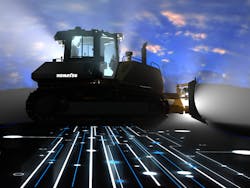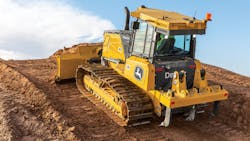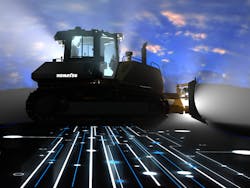Contractors are now behind the wheel of dozers that are more sophisticated than ever before, loaded with features that ramp up safety, efficiency, and comfort.
Sam Meeker, Caterpillar product application specialist, notes that what contractors desire the most in a dozer includes performance, ease of operation, technology, safety, and lower owning and operating costs.
The Next Generation dozer program has targeted several of these key contractor demands with the release of the D5, D6, D6 XE, and the recently announced D7 dozers.
D5, D6, and D6 XE dozers have improved performance in heavy dozing, spreading, and finish grading, says Meeker.
Cabs in Next Generation dozers have been designed to improve access, visibility, comfort, and capability.
“Safety is evident all around with access ladders, grab irons, standard backup cameras, and better visibility all around. Heavier duty structures, undercarriage options, and reduced maintenance tasks all improve O&O cost,” says Meeker.
In addition to the Next Generation D5, D6, and D7 dozers, the D1, D2, and D3 dozers also have received several updates, including better visibility, lower fuel consumption, ease of operation, and improved technology.
Technology for new dozers continues to change rapidly, says Meeker.
“Some of our key updates to the latest release—the D5—improve the operation of the machine in many applications from manual operation to full automatics,” he says.
Slope Indicate—which displays the machine slope to the operator—is a feature on nearly all Cat dozers. The machine monitor shows the fore/aft and side/side slope of the dozer, helping operators work to maintain drainage and get a feel for a certain slope percentage.
It serves as a good training tool, Meeker points out.
Stable Blade—available on the D1 to D7—works like image stabilization does when taking a picture on a phone. It senses movement in the machine and blade commands, helping smooth out the blade response and assist operators in grading smoother passes. It even operates at higher speeds when manually controlling the blade, says Meeker.
ARO (Attachment Ready Option) with Assist also is available on the D1–D7 dozers. It prepares the machine to accept the installation of an aftermarket grade control system such as Laser, GPS, or UTS Robotic Total Station systems.
The ARO also includes the sensors and wiring to install a Cat GRADE with the 3D system, a factory-installed integrated grade control system.
The Assist portion is Cat’s two-dimensional grade control system, Slope Assist. Slope Assist uses sensors on the blade and tractor to help position the blade at a target main fall and side/side blade slope.
Cat GRADE with 3D is an integrated grade control system using Inertial Measurement Unit sensors on the machine, two GPS receivers and antennas, and a new 10-inch color touch screen with the software.
Cat GRADE with 3D is designed to be fully integrated into the dozer.
That means contractors can either order a new machine from the factory with Cat GRADE with 3D or install it at a future time through a local dealer, he adds.
The new 10-inch color touch screen monitor is designed to be as easy to use as a smartphone. It includes simple gestures such as "pinch to zoom," "2-finger pan," "click to select," and "click and hold to edit."
“The GRADE software is extremely capable, even allowing certain designs to be created in the field,” says Meeker.
CAT’s latest technology is shown in its D5 and D7 dozers and includes Traction Control and Blade Load Monitoring, says Meeker.
“These two features use GPS and machine data to calculate dozing loads and track slip on the fly,” he adds. “Blade Load Monitor displays a real-time graphic to the operator describing the current blade load, allowing them to maximize every push.
“Traction Control helps by adjusting torque in high slip conditions to limit track slip and also maximize load. These features work in the background, helping operators to achieve the most productive, most efficient cycles when dozing.”
Another new technology on the CAT Command remote control product line is Command RC Console and Station hardware, enabling remote control of dozers, loaders, excavators, and other products.
“Many contractors expect to have the same features in their dozer that they do in their pickup truck,” notes Cory Brant, product consultant, crawler dozers, John Deere Construction & Forestry.
They seek features such as rear cameras, heated and ventilated seats with leather trim, premium radios with Bluetooth capability, and auto temperature control for heating and cooling, he says.
“The new line-up of L-Series dozers from John Deere includes all of these features to help make these contractors more comfortable,” says Brant.
John Deere recently released the 700L and 750L series dozers.
“These units are building upon the success of the previously released 850L,” says Brant. “John Deere L-Series dozers are designed around improved reliability and durability, increased operator comfort, and performance enhancements to boost productivity.
“All of these dozers are boasting new hydraulic hose and electrical harness routings, newly-designed operator stations that are packed full of high-tech features, and increased engine power and operating weight to handle even bigger tasks.”
The industry continues to shift toward increased use of advanced technology, with advancements in grade control continuing to drive productivity, efficiency, and ease of use, says Brant.
Brant points out that one of the biggest struggles facing contractors today is finding and retaining skilled operators.
To that end, John Deere is developing several features to help overcome this challenge. For dozers, John Deere has developed a 2D Slope Control grade system to help contractors ease into machine control without the need for extra GPS equipment, says Brant.
“This system allows operators to grade specified main falls and/or cross slopes simply using the technology built into the machine itself,” says Brant, adding that the system can be easily be upgraded to the John Deere SmartGrade mastless 3D control system with added features like Auto SmartGrade, enabling operators to dial in specific settings like load levels, material types, and dozing activities. The system automatically controls the blade to reduce track slip and boost productivity.
Contractors also have high expectations for performance and productivity but still need to manage fuel costs, notes Brant.
“To help with this, John Deere has developed additional fuel-saving settings allowing contractors to get more out of each gallon of fuel,” he says. “Settings like auto-idle and auto-shutdown help reduce fuel consumption while the machine is not being used.”
Additionally, John Deere crawlers now have an advanced Eco mode setting.
“That can save up to 20% in fuel consumption without reducing productivity by saving fuel when it makes sense and providing performance when you need it,” he says.
Additionally, John Deere Service ADVISOR Remote allows service technicians to interact with its machines at a greater level to provide faster support and remote diagnostic capability, says Brant.
To increase dozer productivity, Komatsu recently rolled out its intelligent Machine Control 2.0.
Komatsu’s iMC 2.0 paired with the intelligent hydrostatic transmission (HST) dozer, the D71PXi-24, offers proactive dozing control that automatically cuts and strips from existing terrain like an experienced operator.
It can operate automatically 100% of the time, measure the terrain it tracks, and use that track-level data to plan the next pass. It is designed to be more than 60% more productive than the previous generation.
Its lift layer control is designed to automatically spread fill from existing terrain with one press of a button. By using that data in planning the next pass, the machine enables the operator to double production and achieve consistent layers for quality compaction.
Tilt Steering Control automatically tilts the blade to maintain straight travel during rough dozing and reduces the need for operator steering input by up to 80%. A temporary design surface is created with one press of the button.
Combined with other iMC 2.0 functions, operators can begin stripping or spreading using automatic modes while waiting for finish grade mode.
Within the year, Intelligent Machine Control 2.0 is expected to be commercially available on additional Komatsu dozers.
Jonathan Tolomeo, product manager for Komatsu dozers, notes that overall, contractors seek the lowest owning and operating costs for dozers as well as comfort and visibility. Dozers are starting to adopt some comfort features found in consumer vehicles such as Bluetooth radio and heated and ventilated seats found in the D71PXi-24.
“Visibility is huge,” says Tolomeo, adding that Komatsu dozers deliver optimal visibility. “If their visibility is good, they feel comfortable working around ground crews.”
“The technology is becoming adaptive, expanding across the industry,” says Derek Morris, product marketing manager for Komatsu Intelligent Machine Control, adding that contractors are seeking the benefits that can be derived from technology in equipment, especially dozers.
The D71PXi-24 has put Komatsu into a dozer-sized class with two different powertrain availabilities for contractors, says Tolomeo. Some contractors favor the torque converter for applications such as slot dozing, forestry work, and heavy pushing, he adds.
“We’ve had a torque convertor machine in this size class for decades,” says Tolomeo. “Adding its availability on two different machines in the same dozer size class provides more solutions to contractors’ everyday problems.”
Komatsu's next-generation PLUS (parallel link undercarriage system) rotating bushing undercarriage helps lower dozer O & O costs, says Tolomeo.
The Intelligent Machine Control 2.0 builds on early intelligent machine control technology to incorporate improvements addressing some of the problems contractors were having on the job site, says Morris.
Komatsu has added more functionality to the machine control system based on its proactive dozing control.
“It allows the system to act more like an experienced operator,” says Morris. “It gives the machine the ability to see around itself and understand the environment and the terrain it’s working on so the machine can make calculated decisions based on the terrain in front of it.
“In a cutting situation, it can understand when to load the blade and then when to come up out of the ground so that the tracks don't slip.”
Its value is provided from "grass to grade," points out Morris.
In Intelligent Machine Control 2.0, the Lift Layer control feature leverages the technology to put in consistent lifts, serving as a quality control device for compaction based on the existing terrain, says Morris.
Contractors can expand upon the yardage moved in a day, maximizing an area that has to be lifted based on the existing terrain, he adds.
The technology addresses the problems contractors have had not had the proper compaction. Traditionally, the operator had to eyeball the depth of that lift—based on the existing ground on which it is being spread—often resulting in a lift that was too thick. Thus, they couldn't compact it, and would have to rework and compact it again, Morris points out.
Tilt Steering Control is a feature that works proactively in conjunction with the heavy cutting.
“When you’re in a heavy dozing situation and one side of the blade starts to load up a little more than the other, there is a tendency for the machine to start pulling it left or right, which is taking it off the direction that the operator is moving in,” says Morris.
With Tilt Steering Control, as the blade starts to load up and the trajectory of the machine starts to go left or right, contractors can automate the tilt of the blade to keep the machine heading in a straight trajectory toward what they're trying to get to instead of the operator hitting the travel lever left or right to counteract that pull on the blade, he adds.
Current technology options are as sophisticated for dozers as they are for any other type of equipment, notes Cameron Clark, earthmoving business area manager, Trimble’s civil engineering and construction division.
Trimble recently rolled out Horizontal Steering Control for dozers as part of its Earthworks Grade Control System.
The technology automatically controls the machine to follow any horizontal alignment, such as a back of a curb, break line, roadway centerline, or bottom of the slope without operator assistance, says Clark.
“This allows the operator to focus on the grade and machine productivity rather than worrying about steering, reducing operator fatigue and errors,” he says. “It enables the machine to follow the horizontal guidance from the 3D model, providing operators increased awareness of their surroundings, better accuracy, and improved productivity with decreased overlap and fewer passes.”
The system configuration mounts dual GNSS receivers on top of the cab to eliminate masts and cables traditionally located on the blade. The dual GNSS receivers are ideal for steep slope work and complex designs with tight tolerances.
The new configuration keeps valuable receivers safer and is designed to reduce the time needed to remove and reinstall them each day.
The system’s user interface is built on the Android operating system with colorful graphics, natural interactions and gestures, and self-discovery features designed to make the software intuitive and easy to learn.











